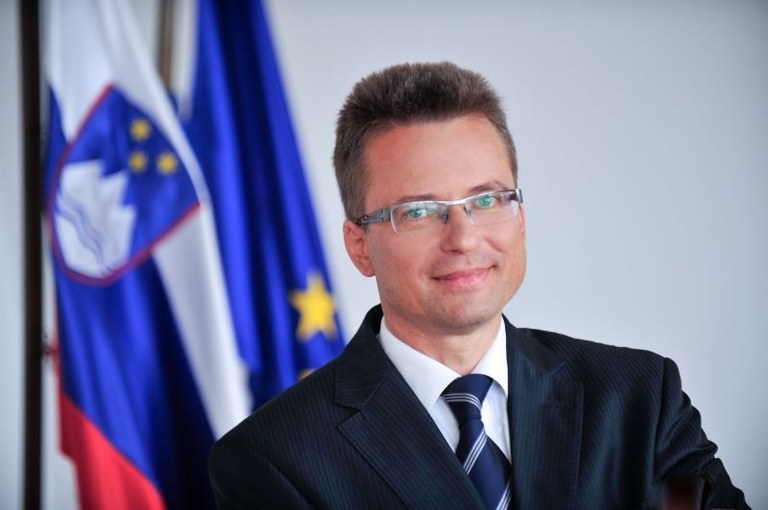
Zvone Černač, Minister competent for Development and the EU Cohesion Policy, was a guest on Radio Ognjišče in the show Pogovor o, giving a more detailed presentation of Slovenia’s Recovery and Resilience Plan, and also responding to various criticisms of the left-wing political option targeted at him as well as the line ministry regarding the preparation of the said Plan.
To the most part, the radio show Pogovor o focused on Slovenia’s Recovery and Resilience Plan that will serve as the basis for drawing on the available funding of EUR 2.5 million and that, inter alia, addresses mitigating the impacts of the COVID-19 epidemic as well as supporting the reforms that the Member States, including Slovenia, should have implemented a long time ago. ‘The process has been long,’ said the Minister revealing that when the agreement was reached on 21 July 2020 everyone believed that the process was going to be a lot shorter. ‘Already in the same week that the agreement was reached, Slovenian established two workgroups to prepare all the necessary bases, however, the formal administrative procedure was so long that we can now – one year after the agreement – only hope that the first recovery and resilience plans are finally approved. Despite the epidemic, the procedures were carried out in accordance with the standard practice and Slovenia did more than OK. Just like the other Member States, Slovenia also tried to find the best solutions that would, on the one hand, keep the economy in shape, preserve as many business entities and jobs as possible and also prevent bankruptcies which would inevitably happen had it not been for the support. On the other hand, the adopted measures helped alleviate social distress. ‘Slovenia was one of the more successful Member States. We adopted eight legislative packages and awarded 3 billion euros of support to preserve tens of thousands of jobs, alleviate social distress, prevent numerous bankruptcies … all of this results in the fact that according to all the indicators the European institutions place Slovenia in the top third of Member States to first exit the crisis, to be the first to achieve high economic growth and to most adequately overcome all the negative impacts,’ said Minister Černač. The Minister also drew attention to Slovenia’s good rating saying that ‘Slovenia is currently borrowing at a negative interest rate which was one of the reasons why we decided not to make use of the entire quota of loans available to Slovenia. Instead, we decided to be economical and rational so the first part of the Plan envisages drawing with just under 700 million euros in loans. The rest, i.e., 2.5 billion euros remails available to Slovenia until August 2023. If the situation changes and if the planned investments require so, the Plan will, of course, be supplemented in order to access the remaining loans.’
The Minister gave a brief presentation of how the Recovery and Resilience Plan was developed. Government Office for Development and European Cohesion Policy acted as the coordinator and invited ministries, municipalities and regional development agencies to get involved in the preparation process. Government Office also coordinated with the Economic and Social Council, entrepreneurs and other stakeholders thus enabling them to present their views. ‘We know that we can’t put 10 litres of water in a jug that holds 1.8 litres of water, which is why we planned measures for the next decade by combining the funds of the Recovery Fund with all other available sources of funding.’
The Minister is convinced that we have a once-in-a-lifetime opportunity as well as a great responsibility to carry out the reforms that we have been postponing for too long. For example, reforming the education system which needs the support of other policies, including the housing policy: ‘The Plan places great emphasis on the housing policy as well. This intertwining of the changes and investments that follow these changes will enable us to improve the systems that have been severely neglected in the past.’ Such systems are healthcare and care of the elderly. ‘I’m convinced that if we had placed more emphasis on the institutional care of the elderly over the past 8 years, the impacts of the COVID19 epidemic would be far less pronounced for Slovenia because people would have a better chance of avoiding getting infected.’
The Minister also responded to the misleading statements made by the KUL coalition which has repeatedly accused the Government of hiding the preparation of the Recovery and Resilience Plan. The fact is that they were given all the information as the communication on individual policies, reforms and essential components took place within the National Assembly. ‘Anyone who wanted to express their opinion could do so by partaking in the discussions. Unfortunately, there were no concrete proposals,’ Minister Černač explained and added: ‘We received proposals from individual sides of the opposition mainly focusing on extensive borrowing. They proposed 14.8 billion euros, which, in my opinion, cannot be realised even by 2036, let alone by 2026, of which about 9 billion euros was proposed as loans.’ We are well aware of this kind of borrowing from the past, so the Recovery and Resilience Plan that we submitted to the European Commission is above all economical and rational.
The Minister also said that Slovenia will use all the funds available over the coming years, all the while being economical in order to make the impacts visible.





